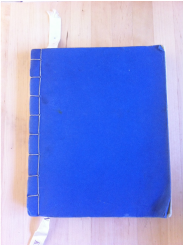Granted, back then it was in an edition of 12 copies only and I published in March 1998 under the imprint Avocado Press while completing my undergrad studies at Kenyon College. I'd just learned how to make books from the artist and professor Claudia Esslinger. I'd taken a screenprinting course from her and was totally thrilled by the Japanese style binding she showed us. I'd written the book as an Honors English project and wanted a sense of completion by producing it as a book, so I used the techniques she showed me to produce the small run. (I've gone on to produce dozens of handmade books with the skills she taught me.) One of those funky first versions of Women Float still lives at the school's library.
Fast forward 15 years of carrying that strange purple-blue handmade book around to Colorado, Baton Rouge, New Orleans, San Francisco and finally back to Carpinteria to January of this year when I first found out from Jason Pettus at CCLaP that the book was getting a second life. After recovering from the joyful shock of getting to see the book published (via e-mail while waiting for my order in a Santa Barbara In 'N Out burger joint) I dug out the original version and thumbed through it. Then, for fun, I photographed them. I've placed them side by side above this post.
Seeing all four images together, I was struck both by their similarities and differences. In terms of colors, both books feature blues and greens. Mine, of course, was produced at the very embryonic moment of the Internet and digital age, so while I laid it out on a word processing program and printed it out with my own printer, the pages are photocopied onto a nice cream paper. On the other hand, the CCLaP version is a complete stepchild of the Internet: the web is how I found CCLaP and the photographer who did the cover image, how I'm editing the book and how I'm talking to you about it now.
Again, seeing them all, I'm struck by the sheer moxie, persistence, stubborn drive it takes to give a book life sometimes. Fifteen years of stupid insistence that Women Float see the light of day. But it wasn't me. It was the mermaids. I credit the fantastic creatures with guiding this book into its final form. I think they worked while I slept, like the shoemaker's elves, to swim this book to the world. In their honor, I painted a mermaid onto a bus bench yesterday at my hometown's annual volunteer bus bench painting day (see the photograph of her below). Now, she'll look over the city and its visitors everyday with that coy, siren's smile, beckoning all to imagine the things that exist beyond the real. Creativity, folks. Like taking the bus, it's both totally ordinary and a daily essential. Long live the mermaids and long live your own personal artistic ambitions!





 RSS Feed
RSS Feed
